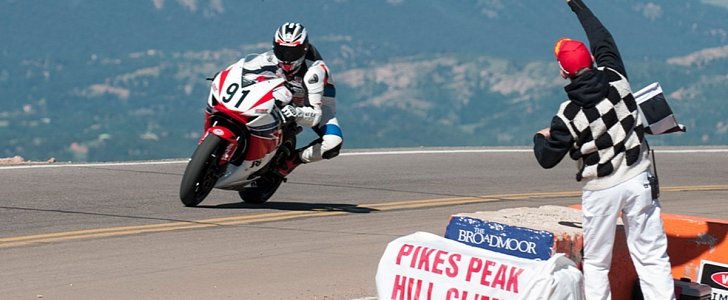A week before Christmas, the organizers of the Pikes Peak International Hill Climb (PPIHC) announced that the bikes originally equipped with clip-on handlebars would no longer be accepted in the Race to the Clouds. The PPIHC officials are back with explanations, but things are not exactly clear yet.
For starters, we will remind you that the organizers of the PPIHC reintroduced an older rule that was enforced until 2012. The new sporting rule stated that "Only motorcycles manufactured with one-piece handle bars as original equipment will be permitted. Only OVM one-piece handlebars will be permitted. This Rule does not apply to bikes in the Pikes Peak Challenge Sidecar Class."
In the first place, the new rule was regarded as an express method of banning sport bikes from the race. The PPIHC saw two riders killed in crashes that involved sport bikes, and these machines and the fatalities were put in relation, even though it was not the sport bikes that dominated the race.
Back in 2014, Bobby Goodin lost his life crashing his Triumph Daytona 675R right after crossing the finish line. This year, Carl Sorensen went off track aboard a Ducati 848 and was killed as well. It's easy to imagine that the fatalities and the sport bikes were linked, and some reports even mentioned the possibility of banning motorcycles from the race altogether.
The clip-ons "encourage a crouched, horizontal riding position and low vantage point in comparison" (with the standard bars, red.). "One key reason the PPIHC Race Committee and Board of Directors are only comfortable allowing motorcycles originally produced by manufacturers with top mounted one-piece handlebars is the vertical riding position and high vantage point these bikes encourage. The Pikes Peak Highway is an extremely unique race course with many crests and the potential for wildlife like deer, big horn sheep, and even bear to also be on the race course while riders ascend to the mountain’s summit.
Due to limiting factors associated with a rider’s ability to see and react as early as possible to these and countless other unpredictable conditions found at Pikes Peak, the PPIHC is no longer comfortable with the riding position and vantage point associated with and encouraged by motorcycles equipped with two-piece clip-on style handles," a PPIHC release adds.
"To clarify, nowhere in the PPIHC Rule Book does it state that sportsbikes are not allowed to compete at the PPIHC. Competitors are more than welcome to apply for an invitation to compete in the PPIHC with a sportsbike as long as it was produced by the manufacturer with one-piece handlebars and the original handlebars are used," the PPIHC release continues.
It doesn't take a motorcycle industry specialist to figure out that this is a politically correct way of putting things in such a way so that the traditional fully-faired sportbikes are impossible to enter the Pikes Peak race next year. So we guess it's going to be the Ducati Multistrada defending its title against the KTM 1290 Super Duke R...
In the first place, the new rule was regarded as an express method of banning sport bikes from the race. The PPIHC saw two riders killed in crashes that involved sport bikes, and these machines and the fatalities were put in relation, even though it was not the sport bikes that dominated the race.
Back in 2014, Bobby Goodin lost his life crashing his Triumph Daytona 675R right after crossing the finish line. This year, Carl Sorensen went off track aboard a Ducati 848 and was killed as well. It's easy to imagine that the fatalities and the sport bikes were linked, and some reports even mentioned the possibility of banning motorcycles from the race altogether.
The clip-on handlebars come with a low riding position that may prevent riders from spotting on-course hazards
Now, the PPIHC organizers step in with a detailed explanation for the new rule, stating that the riding position on motorcycles equipped with clip-on handlebars may impact a rider's capability to detect hazards on the track.The clip-ons "encourage a crouched, horizontal riding position and low vantage point in comparison" (with the standard bars, red.). "One key reason the PPIHC Race Committee and Board of Directors are only comfortable allowing motorcycles originally produced by manufacturers with top mounted one-piece handlebars is the vertical riding position and high vantage point these bikes encourage. The Pikes Peak Highway is an extremely unique race course with many crests and the potential for wildlife like deer, big horn sheep, and even bear to also be on the race course while riders ascend to the mountain’s summit.
Due to limiting factors associated with a rider’s ability to see and react as early as possible to these and countless other unpredictable conditions found at Pikes Peak, the PPIHC is no longer comfortable with the riding position and vantage point associated with and encouraged by motorcycles equipped with two-piece clip-on style handles," a PPIHC release adds.
Sport bikes are not explicitly banned, but...
In the absence of a regulation that bans sport bikes, we might be tempted to believe that things are easy to circumvent by simply installing a one-piece handlebar on a Ninja, or so. Well, not quite so because only the original bars will be taken into consideration."To clarify, nowhere in the PPIHC Rule Book does it state that sportsbikes are not allowed to compete at the PPIHC. Competitors are more than welcome to apply for an invitation to compete in the PPIHC with a sportsbike as long as it was produced by the manufacturer with one-piece handlebars and the original handlebars are used," the PPIHC release continues.
It doesn't take a motorcycle industry specialist to figure out that this is a politically correct way of putting things in such a way so that the traditional fully-faired sportbikes are impossible to enter the Pikes Peak race next year. So we guess it's going to be the Ducati Multistrada defending its title against the KTM 1290 Super Duke R...
